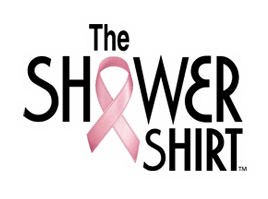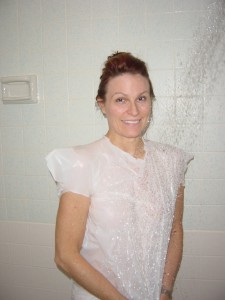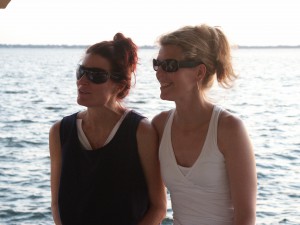Blog
The Unexpected Surgery
Before Reading this Blog PLEASE NOTE: I have included photo’s (post-infection) which could be considered rather repulsive. However, since I’ve chosen to bear my soul psychologically, I felt it was only fair to do the same physically. Breast cancer leaves emotional scars, but can also leave huge physical scars, depending on complications and surgical outcomes. I’m hoping my Blog readers understand the spirit behind sharing the enclosed photo’s.
 At 7 am the following morning I was rolled to surgery. It was an eerie atmosphere since it was a Sunday and no surgeries (except emergencies) were scheduled at that time. Comparable to being in a retail shop when the store is closed, the hospital halls were dark and only staff on-call for emergency purposes were on deck. Dr. Z was obviously there as he was responsible for surgically removing the infected tissue expander (however, I’m still not sure he had actually accepted the fact that I had an infection – LOL!!). I was still pretty out of it, between the ongoing drugs pumped into my body through IV for pain, and the strong dosages of Xanax from the nice nurse the day before.
At 7 am the following morning I was rolled to surgery. It was an eerie atmosphere since it was a Sunday and no surgeries (except emergencies) were scheduled at that time. Comparable to being in a retail shop when the store is closed, the hospital halls were dark and only staff on-call for emergency purposes were on deck. Dr. Z was obviously there as he was responsible for surgically removing the infected tissue expander (however, I’m still not sure he had actually accepted the fact that I had an infection – LOL!!). I was still pretty out of it, between the ongoing drugs pumped into my body through IV for pain, and the strong dosages of Xanax from the nice nurse the day before.
In reliving this ordeal, I now realize I literally had no options or decisions in this surgery. Not that I could have, or would have taken a different route, but I was totally beholden to this surgeon, the anesthesiologist and the nurse on call to get this infected object out of my body. I knew Dr. Z held impressive medical credentials and surgical talent, but obviously sucked when it came to bedside manner and the needed sensitivity and compassion for this type of situation.
The surgery was over within two hours and I slept the rest of the day. By the following morning, I felt much better, the infectious tissue expander was removed from the chest wall, leaving an elongated rib. The chest cavity was thoroughly flushed and another surgical drain was attached and tied in a knot to drain any additional infection from the area..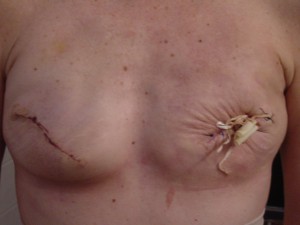
Besides knowing this was a major setback, I expected it would now be much more difficult to resume the original plan of reconstruction. Dr. Z came in that following afternoon to announce (for the record) since I had already attained one infection, he would not be able to rebuild the left breast if I attained another. It seemed as if my parent was scolding me, comparable to “you are in trouble, if you get into trouble again, you are grounded.”
In a nutshell, the future was somewhat unknown depending on how my body healed from this infection. In the meantime, I was left mentally and physically exhausted, no left breast, a nasty looking knotted drain, scarring, and a right tissue expander. As I had mentioned in one of my previous Blogs, I was never emotionally connected to my breasts in the first place, but I definitely preferred to have two versus only one; unfortunately, that preference was not possible at this point.
Stay Tuned,
Lisa F. Crites
The Shower Shirt Co., Founder/Inventor
Health/Medical Print Journalist & Guest Columnist
Still In The Hospital
 After six days in the hospital and multiple lab tests to identify the nature of my ‘hospital acquired’ infection, luckily, it was not MRSA, but a methicillin ‘sensitive’ form of Staph infection that could possibly be controlled with antibiotics. However, they had to find the correct antibiotic as the first four they pumped into my body were not diminishing the infection.
After six days in the hospital and multiple lab tests to identify the nature of my ‘hospital acquired’ infection, luckily, it was not MRSA, but a methicillin ‘sensitive’ form of Staph infection that could possibly be controlled with antibiotics. However, they had to find the correct antibiotic as the first four they pumped into my body were not diminishing the infection.
On many occasions, I’ve told friends I felt I lost a week and a half of my life during that hospital stay. I sincerely don’t remember much about it except I was extremely dizzy and in physical pain. I needed help climbing in and out of the hospital bed as the infection had also migrated to my abdomen, so I still had no core strength. I do remember waking up to see flowers in my hospital room and briefly speaking with my significant other, Phil, but otherwise, I don’t remember much else. There is a part of me which believes I don’t want to remember what happened, but the other part chooses to believe my lack of memory is due to post-traumatic stress disorder (PTSD), because the ordeal was so frightening. Maybe it was best (at the time) I didn’t realize how sick I was. It was only later when my friends were concerned I would not pull through; something that didn’t cross my mind at the time.
I do however believe that the team of physicians knew all along that the infection was severe enough it would be difficult to overcome. A couple of times the infectious disease doctor mentioned that in most circumstances, when implanted objects become infected, they are normally ever “right,” and the patient continues to have issues. Not knowing what he meant at the time, I just said “ok.”
After nine days in the hospital, the infectious disease physician came into my room, sat down, and said they could not get the infection under control. They would need to surgically remove the left tissue expander, immediately. At that point, I lost every bit of emotional strength I had. Even typing this Blog, I have a nervous feeling in my stomach and am tearing up. I had tried so hard to be strong after the diagnosis; strong when I went through the mastectomy, and stay strong when I became sick, but I had no more emotional strength when I found out I had to go through yet another surgery with unknown consequences.
Upon the doctor exiting, my nurse came in, set down on my bed, and asked if I was familiar with Xanax. Since I was in the throes of my emotional breakdown, I couldn’t speak so I just nodded. She said she would order a strong dose STAT.
I knew enough about these types of infections to know this was the beginning of a long complicated process. I was right.
Stay Tuned,
Lisa F. Crites
The Shower Shirt Co., Founder/Inventor
Health/Medical Print Journalist & Guest Columnist
Back In The Hospital
 So imagine this visual. I was just admitted to the hospital by the Emergency Room (ER) physician with a major infection in my left breast tissue expander. The hospital transporter was literally rolling me on a stretcher from the emergency department to my room with tubes and IV’s hanging from all areas of my body. The reconstructive physician, Dr. Z, who blew me off in the middle of the night calls my cell phone. My significant other answers (Dave, but remember we call him Phil) and gave the phone to me. The physician proceeds to tell me that even though I have an 18,000 white blood cell count, even though they are admitting me into the hospital with 103 temperature and even though the emergency department physician told me I had a major infection, he said, “Lisa, I still don’t believe you have an infection.”
So imagine this visual. I was just admitted to the hospital by the Emergency Room (ER) physician with a major infection in my left breast tissue expander. The hospital transporter was literally rolling me on a stretcher from the emergency department to my room with tubes and IV’s hanging from all areas of my body. The reconstructive physician, Dr. Z, who blew me off in the middle of the night calls my cell phone. My significant other answers (Dave, but remember we call him Phil) and gave the phone to me. The physician proceeds to tell me that even though I have an 18,000 white blood cell count, even though they are admitting me into the hospital with 103 temperature and even though the emergency department physician told me I had a major infection, he said, “Lisa, I still don’t believe you have an infection.”
OK, so the long history of Crites crazy genes had to come out sometime and this was the time!!!!
I said Dr. Z, “You have got to be f’ing kidding me. I have been sick for nearly 24 hours, I have this gross green puss coming from my left armpit, the entire left side of my chest is blood red and you are sitting at your office diagnosing a non-infection without seeing me because you punted me to my primary care physician? Furthermore, the clinicians here at the hospital, who have been examining me for the last four hours are telling me the opposite of what you are trying to make me believe. You need to get on the same page as everyone else or you are fired.”
Wow, after four years, does that feel good to get out!!!! Needless to say, I hung up on him.
I don’t remember much after that as I was in so much physical pain the clinicians kept me drugged. I do remember the infection was deep into the chest and stomach tissue (commonly known as cellulitis) I could hardly sit up or lie down by myself; I literally had no core strength. They continued to take the drainage from the post-surgical drain for testing in trying to figure out the specific strain of infection. At one time they expected it was methicillin-resistant staph infection, otherwise known as MRSA, and discussed the possibility of having my hospital room quarantined until the pathology report was completed, and the specific strain of infection was confirmed.
I spent the first couple of nights at Wuesthoff Medical Center, and then transferred by ambulance to their sister hospital, where I was then referred to an infectious disease doctor. That physician, along with my primary care physician, Dr. Mostafavi, worked together on a care plan for what was stated as a ‘hospital acquired’ infection.
By the way, finally, after 48 hours, Dr. Z blessed me with a visit; when he saw my chest his eyes became HUGE, he sat down and was speechless. I then said, “Dr. Z, do you think I have an infection now?”
Statistically, surgical site infections after breast cancer surgery are decently high in nature with healthcare costs associated being enormous. In a recent study conducted by the American Hospital Association, out of 1,000 patients, surgical site infections were identified in:
• 4.4% of patients following a mastectomy
• 12.4% of patients following a mastectomy surgery with implants
• 6.2% of patients following a mastectomy using a procedure known as a TRAM flap
Of these cases, 96% were readmitted to the hospital.
Stay Tuned,
Lisa F. Crites
Shower Shirt Principal/Inventor
Corporate Healthcare Consultant
Health/Medical Broadcast Journalist
A Life-Threatening Infection
Two weeks after mastectomy surgery, I went to bed feeling somewhat dizzy. I woke up at 2 am and felt as if I was having a heart attack as I had pain radiating up and down my left arm. I struggled to the bathroom but quickly passed out. I was able to regain consciousness and immediately called my surgeon who had performed my breast reconstruction surgery (Dr. Z). I told him what had happened and asked if he thought I might have an infection, based on the pain in my chest. He quickly said, “I saw you at 4 pm yesterday; you had no signs of an infection so go back to bed. If you don’t feel better in the morning, call your primarily care physician.” I was confused since I had explained I was running a temperature of 103, had passed out and my post-surgical drain had thick mucus liquid draining into it. However, since we are conditioned to trust our physicians (most of them anyway), I went back to bed as instructed.
By 8 am, the following morning, I couldn’t hold my head up. My significant other David, though I call him Phil, was out of town and his brother, Robert, was staying with me. I texted Robert and asked him to come upstairs when he awoke as I was sick and needed help getting down the steps. As instructed by Dr. Z, I phoned my primary care physician, Dr. Mostafavi, who said, “Call 911 immediately and get to the emergency room.” I did just that and was in the ER within 45 minutes.
The ER physician ran a STAT blood test and my white blood cell count was 18,000 (normal is 4,500 to 10,000) and stated I had a severe surgical site infection in my left tissue expander. (After mastectomy surgery, if a patient chooses to immediately undergo breast reconstruction, the surgeon places a tissue expander in the socket to keep the skin stretched before an implant is placed). The ER physician also stated I was lucky to still have one of the post-surgical drains in place as it was helping to drain infected fluid; otherwise, I could have been septic, a clinical term referring to pathogenic organisms in the bloodstream caused by a serious infection. (Remember, I was a health/medical reporter and love this clinical jargon!!!)
With that, the ER physician admitted me to the hospital.
This entire experience reminded me of a conversation I had with Fran Dresher (actress of the TV show ‘The Nanny’ and uterine cancer survivor), who I met while coordinating media interviews at a cancer charity event. Fran, whose diagnosis of uterine cancer was delayed by more than two years despite multiple physician encounters attempting to find the problem, spoke frankly about her misdiagnosis, and the importance of being her own healthcare advocate. She said, “I don’t let anyone be in sole control of my money, why would I let anyone be in sole control of my body or healthcare decisions. We have become infantile because we let doctors make all of our healthcare decisions for us.”
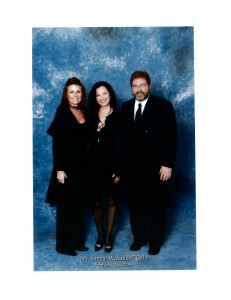
That statement stuck with me, long before I was ever diagnosed with breast cancer. The moral of this story is when it comes to your health, always follow your intuition. I knew I was gravely ill that morning but chose to listen to my physician because I was physically and emotionally vulnerable. At the time, I thought he was more knowledgeable than me in making the best decisions regarding my health ……
In the meantime, I’ve enclosed a photo of Fran, myself, and my brother Shawn. Check out Fran’s website at www.cancerschmancer.org.
Stay Tuned,
Lisa F. Crites
Shower Shirt Principal/Inventor
Corporate Healthcare Consultant
Health/Medical Broadcast Journalist
The Trash Bag & Devastating Complications
 Women have been going through mastectomies for 75 years in this country. Why was there not a water-resistant product to protect me while in the shower after amputation of my breasts? Why was I required to wrap a trash bag around my body for protection? A question I’ve repeated many times while doing speaking engagements and television interviews across the country; to this day, that question still confuses me.
Women have been going through mastectomies for 75 years in this country. Why was there not a water-resistant product to protect me while in the shower after amputation of my breasts? Why was I required to wrap a trash bag around my body for protection? A question I’ve repeated many times while doing speaking engagements and television interviews across the country; to this day, that question still confuses me.
Every time I showered I became increasingly annoyed and frustrated; I was essentially fighting with a plastic trash bag in trying to keep my surgical drain sites dry. During this physically painful convalescent period, I was on short-term disability and only working part-time, therefore, plenty of time THINK!!!! To occupy my brain, I began speaking with breast cancer patients who had gone through mastectomy surgery, while also interviewing physicians in trying to gather opinions as to why a water-resistant product did not exist for patients like me. Every patient I spoke with said, “I too used a trash bag or Saran® wrap.”
All patients had the commonality of trying different contraptions to shower, but all had the same opinions that their make-shift product didn’t work and their drain sites normally became wet anyway. In terms of physician comments, it basically went like this, “I’ve been doing this type of work for many, many years, no water-resistant product exists for these surgery patients. It’s a need. Go for it.”
Of course, in my experience, saying “Go for it,” is always easier said than done!
Photo While Showering With My Trash Bag
I then began hearing this loud, annoying, nagging voice in my head, “Create a water-resistant product for surgery patients, create a water-resistant product for surgery patients.” Of course I tried to ignore the voice since I’ve heard voices in my head for years. (Yes, my close friends who are reading this blog are now laughing!!!)
As time passed, that same voice became a calming, directive voice; a voice that was guiding me to a path to ignore all rationale and logic. I would often argue with my ‘new calming head voice’ and say; “Are you crazy”? I have just had surgery and have drain tubes coming out of my body. How can I start a project to create a water-resistant product for surgery patients?”
However, common sense told me if a breast cancer surgery patient could shower, they would feel better physically, thus psychologically and emotionally; something mastectomy patients gravely need during the healing process. So, with that in mind, my ‘voice’ ultimately convinced me to begin designing a product to allow surgery patients to bathe themselves safely without being required to depend on plastic trash bags for showering. But before I could start helping these patients, I was back in the hospital with a life-threatening, hospital acquired infection, thus, an unexpected surgery.
Stay Tuned,
Lisa F. Crites
The Shower Shirt Co., Founder/Inventor
Health/Medical Print Journalist & Guest Columnist
The Trash Bag after Mastectomy Surgery
 One doesn’t have time to deal with the reality of no breasts when unbearable pain is the sole focus. The morning after my surgery, the pain on the right side of my chest was so severe I could hardly breathe, and constant, with no reprieve, as if an arrow had been shot directly into my chest. I was of course complaining about the pain and the general surgeon, Dr. O’Linde, who had actually performed the mastectomy said, “Lisa, the breast which had the cancer is the one which normally causes the most pain after surgery.” HE WAS IN FACT CORRECT!!!
One doesn’t have time to deal with the reality of no breasts when unbearable pain is the sole focus. The morning after my surgery, the pain on the right side of my chest was so severe I could hardly breathe, and constant, with no reprieve, as if an arrow had been shot directly into my chest. I was of course complaining about the pain and the general surgeon, Dr. O’Linde, who had actually performed the mastectomy said, “Lisa, the breast which had the cancer is the one which normally causes the most pain after surgery.” HE WAS IN FACT CORRECT!!!
In comes Dr. Z, (this is not his real name) the breast reconstructive surgeon responsible for placing the tissue expanders placed in my chest immediately after my mastectomy. With my cousin Mandy sitting by my side, he took the bandages off one by one. I could see Mandy trying not to look startled, but I knew she was. She mouthed quietly, “It doesn’t look that bad.” With that, I started laughing; years ago, when she had half of her nose surgically removed due to skin cancer, I said the same thing to her, “It doesn’t look that bad,” and for the record, I was not telling her the truth either.
Dr. Z directed me to get out of bed and walk. That’s when I realized I had four post-surgical drains sutured into my armpits extending down to my knees. The doctor then said, “You cannot take a shower until those drains are removed.” When I asked why, he said, “In essence, what comes out of the shower head is not sterile. By showering without protecting the drain sites you will drastically increase the chance of a surgical site infection. I asked, “How long will I need to take these precautions?” He said, “Two to three weeks or until the drains are removed.”
With that, I remember saying (very loud), “I’ve just had my breasts cut off, I have dried blood on my chest, I smell like a hospital, my hair is greasy and I can’t even shower? ” At the time, something as small as taking a shower was a HUGE issue, thus, the tears began to flow again.
In came my father and his wife (yes, he got married immediately after my mother died). They began arguing about who was going to stay at the hospital with Mandy and I that day. Next, the nurse comes back in and tells both of them to take their issue out in the hall. At that, I decided to laugh because in my 42 years I’ve never seen anyone tell my dad what to do and get away with it. At that point, my day (even in pain and without breasts) got just a little bit brighter.
After being discharged from the hospital, I was home and began looking online to purchase a water-resistant garment to protect the mastectomy drains. YIKES, NO WATERPROOF GARMENT EXISTED FOR BREAST CANCER PATIENTS WHO NEEDED PROTECTION WHILE SHOWERING!!!! I used a plastic trash bag and tied the drawstring around my neck to protect my chest region, an awkward, frustrating and degrading experience. Thus, I had GREAT idea.
In closing for this week, I am forwarding a link to the website, Embracing Mastectomy, a great resource for breast cancer information and post-operative healing tips. http://www.embracingmastectomy.com. I’ve also added an FAQ giving clinical reasons why mastectomy patients cannot shower until post-surgical drains are removed: http://www.theshowershirt.com/FAQs.html
Mandy & Me At Home After Being Discharged From The Hospital
P.S.: Thanks for all of your nice notes and comments. I’ve been surprised to hear from so many individuals from all over the world (I didn’t realize so many people followed Blogs). Please make sure to subscribe and share my weekly blog with someone who might need it.
Stay Tuned,
Lisa F. Crites
The SHOWER SHIRT Co., Founder/Inventor
Health/Medical Print Journalist & Guest Columnist
